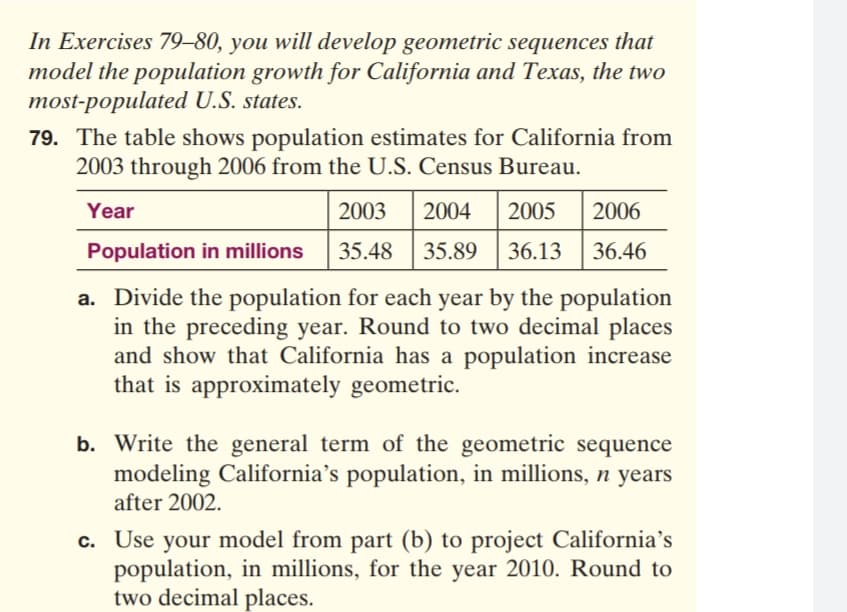79. The table shows population estimates for California from 2003 through 2006 from the U.S. Census Bureau. Year 2003 2004 2005 2006 Population in millions 35.48 35.89 36.13 36.46 a. Divide the population for each year by the population in the preceding year. Round to two decimal places and show that California has a population increase that is approximately geometric. b. Write the general term of the geometric sequence modeling California's population, in millions, n years after 2002. c. Use your model from part (b) to project California's population, in millions, for the year 2010. Round to two decimal places.
79. The table shows population estimates for California from 2003 through 2006 from the U.S. Census Bureau. Year 2003 2004 2005 2006 Population in millions 35.48 35.89 36.13 36.46 a. Divide the population for each year by the population in the preceding year. Round to two decimal places and show that California has a population increase that is approximately geometric. b. Write the general term of the geometric sequence modeling California's population, in millions, n years after 2002. c. Use your model from part (b) to project California's population, in millions, for the year 2010. Round to two decimal places.
Algebra & Trigonometry with Analytic Geometry
13th Edition
ISBN:9781133382119
Author:Swokowski
Publisher:Swokowski
Chapter10: Sequences, Series, And Probability
Section10.3: Geometric Sequences
Problem 81E
Related questions
Topic Video
Question

Transcribed Image Text:79. The table shows population estimates for California from
2003 through 2006 from the U.S. Census Bureau.
Year
2003
2004
2005
2006
Population in millions
35.48
35.89
36.13
36.46
a. Divide the population for each year by the population
in the preceding year. Round to two decimal places
and show that California has a population increase
that is approximately geometric.
b. Write the general term of the geometric sequence
modeling California's population, in millions, n years
after 2002.
c. Use your model from part (b) to project California's
population, in millions, for the year 2010. Round to
two decimal places.
Expert Solution
This question has been solved!
Explore an expertly crafted, step-by-step solution for a thorough understanding of key concepts.
This is a popular solution!
Trending now
This is a popular solution!
Step by step
Solved in 4 steps with 3 images

Knowledge Booster
Learn more about
Need a deep-dive on the concept behind this application? Look no further. Learn more about this topic, probability and related others by exploring similar questions and additional content below.Recommended textbooks for you

Algebra & Trigonometry with Analytic Geometry
Algebra
ISBN:
9781133382119
Author:
Swokowski
Publisher:
Cengage


College Algebra
Algebra
ISBN:
9781305115545
Author:
James Stewart, Lothar Redlin, Saleem Watson
Publisher:
Cengage Learning

Algebra & Trigonometry with Analytic Geometry
Algebra
ISBN:
9781133382119
Author:
Swokowski
Publisher:
Cengage


College Algebra
Algebra
ISBN:
9781305115545
Author:
James Stewart, Lothar Redlin, Saleem Watson
Publisher:
Cengage Learning


College Algebra (MindTap Course List)
Algebra
ISBN:
9781305652231
Author:
R. David Gustafson, Jeff Hughes
Publisher:
Cengage Learning

Glencoe Algebra 1, Student Edition, 9780079039897…
Algebra
ISBN:
9780079039897
Author:
Carter
Publisher:
McGraw Hill